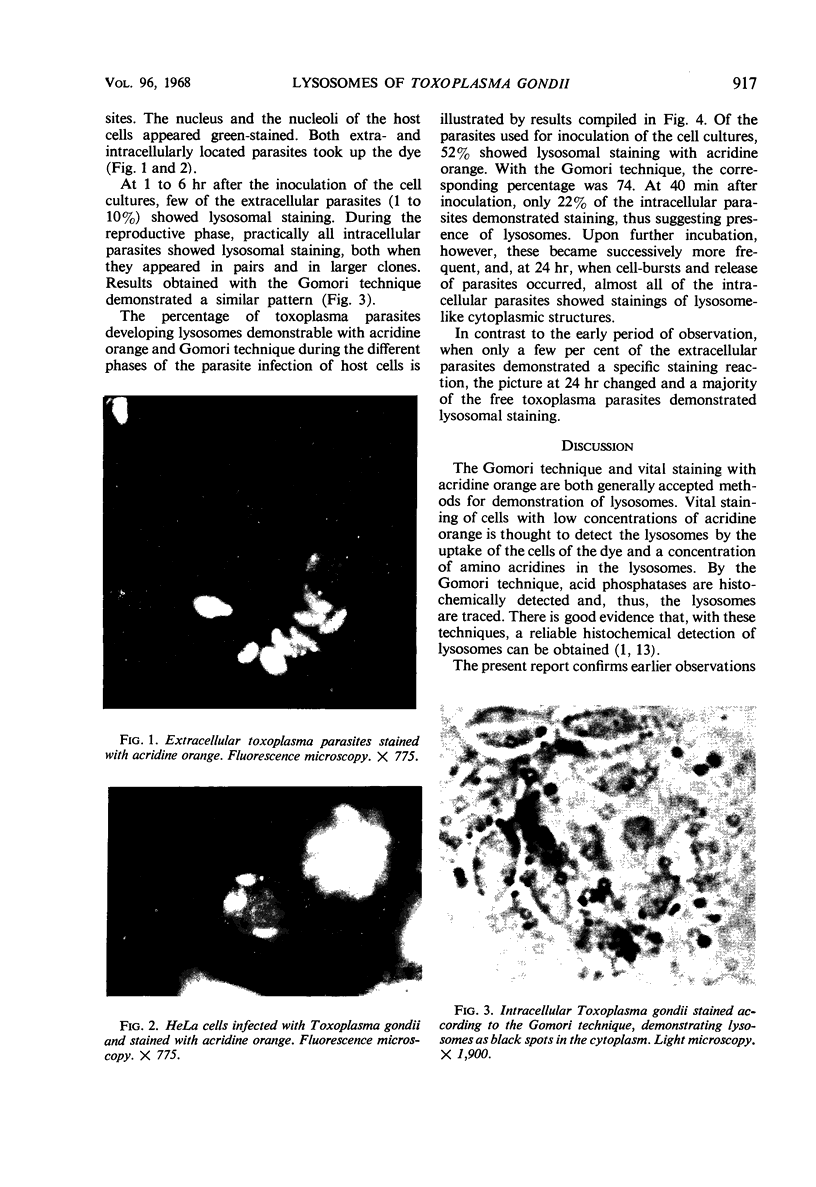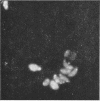Abstract
Lysosome-like structures of Toxoplasma gondii were observed by means of vital staining with acridine orange and by the Gomori technique. These structures were found scattered over the cytoplasm but were often located at one end of the parasite. In comparison with parasites of the inoculum used for infecting HeLa cell cultures, the toxoplasma which had penetrated the HeLa cells revealed a markedly lower percentage of parasites showing lysosomal staining. After the penetration, the number of parasites with demonstrable lysosomes increased successively and, at the time for release of newly formed parasites (at 24 hr), the majority of the parasites demonstrated lysosome-like bodies in the cytoplasm. The observations are discussed with special reference to the mechanism of host-cell penetration.
Full text
PDF



Images in this article
Selected References
These references are in PubMed. This may not be the complete list of references from this article.
- ALLISON A. C., MALLUCCI L. HISTOCHEMICAL STUDIES OF LYSOSOMES AND LYSOSOMAL ENZYMES IN VIRUS-INFECTED CELL CULTURES. J Exp Med. 1965 Mar 1;121:463–476. doi: 10.1084/jem.121.3.463. [DOI] [PMC free article] [PubMed] [Google Scholar]
- ALLISON A. C., YOUNG M. R. UPTAKE OF DYES AND DRUGS BY LIVING CELLS IN CULTURE. Life Sci. 1964 Dec;3:1407–1414. doi: 10.1016/0024-3205(64)90082-7. [DOI] [PubMed] [Google Scholar]
- GARNHAM P. C., BAKER J. R., BIRD R. G. Fine structure of cystic form of Toxoplasma gondii. Br Med J. 1962 Jan 13;1(5271):83–84. doi: 10.1136/bmj.1.5271.83. [DOI] [PMC free article] [PubMed] [Google Scholar]
- Kishida T., Kato S. Autoradiographic studies on intracytoplasmic multiplication of Toxoplasma gondii in FL cells. Biken J. 1965 Jun;8(2):107–113. [PubMed] [Google Scholar]
- LUND E., LYCKE E., SOURANDER P. A cinematographic study of Toxoplasma gondii in cell cultures. Br J Exp Pathol. 1961 Aug;42:357–362. [PMC free article] [PubMed] [Google Scholar]
- LYCKE E., LUND E. ENHANCEMENT BY LYSOZYME AND HYALURONIDASE OF THE PENETRATION BY TOXOPLASMA GONDII INTO CULTURED HOST CELLS. Br J Exp Pathol. 1965 Apr;46:189–199. [PMC free article] [PubMed] [Google Scholar]
- Lund E., Hansson H. A., Lycke E., Sourander P. Enzymatic activities of Toxoplasma gondii. Acta Pathol Microbiol Scand. 1966;68(1):59–67. doi: 10.1111/apm.1966.68.1.59. [DOI] [PubMed] [Google Scholar]
- Lycke E., Norrby R., Remington J. Penetration-enhancing factor extracted from Toxoplasma gondii which increases its virulence for mice. J Bacteriol. 1968 Sep;96(3):785–788. doi: 10.1128/jb.96.3.785-788.1968. [DOI] [PMC free article] [PubMed] [Google Scholar]
- Norrby R., Lycke E. Factors enhancing the host-cell penetration of Toxoplasma gondii. J Bacteriol. 1967 Jan;93(1):53–58. doi: 10.1128/jb.93.1.53-58.1967. [DOI] [PMC free article] [PubMed] [Google Scholar]
- ROBBINS E., MARCUS P. I., GONATAS N. K. DYNAMICS OF ACRIDINE ORANGE-CELL INTERACTION. II. DYE-INDUCED ULTRASTRUCTURAL CHANGES IN MULTIVESICULAR BODIES (ACRIDINE ORANGE PARTICLES). J Cell Biol. 1964 Apr;21:49–62. doi: 10.1083/jcb.21.1.49. [DOI] [PMC free article] [PubMed] [Google Scholar]





